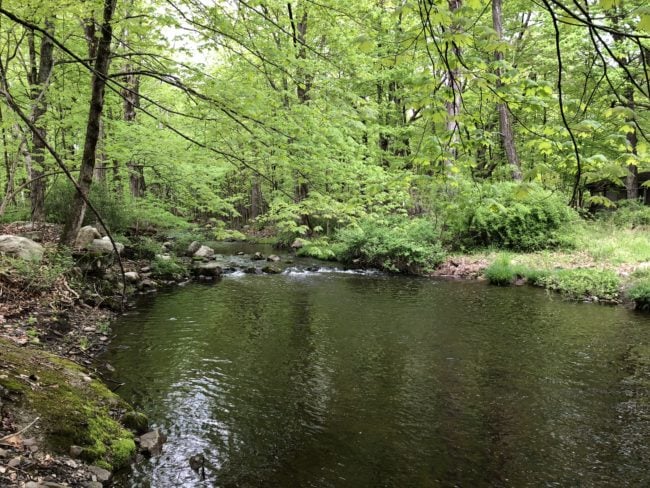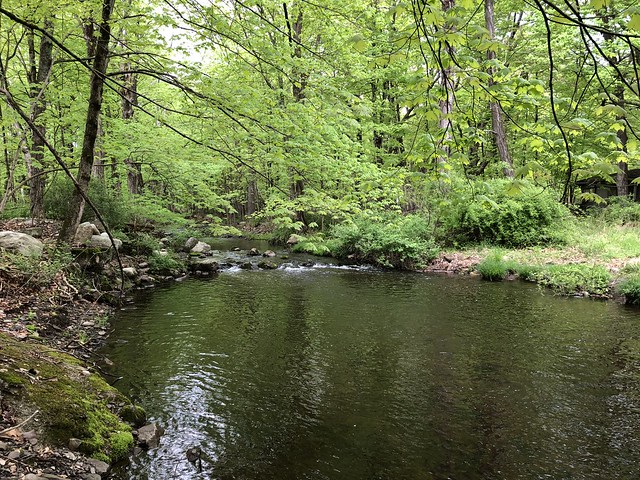Save the Palmaghatt Kill – remove Tillson Lake dam & restore natural flow

View more images on our Flickr site
Almost 15 years ago, “Save the Ridge” signs sprouted up throughout Ulster County, as residents who loved the wild and scenic Shawangunk Ridge banded together to, ultimately, defeat a proposal to develop 2,500 acres on the steep slopes below the cliffs. The people won that fight, and the Awosting Reserve, as the land was known, was added to the Minnewaska State Park Preserve in 2006. Around that time, Tillson Lake was also incorporated into Minnewaska State Park Preserve. Now, fast forward to today, we need to restore the wild waters flowing off the ridge by removing the dam that blocks the otherwise free-flowing Palmaghatt Kill.
The Palmaghatt Kill originates near Lake Minnewaska, and flows through a deep ravine, with the popular Gertrude’s Nose cliffs framing one side of its valley. This is an ancient and wild ravine, where many hemlocks have been dated at well over 400 years old. The Palmaghatt drains the lands of the Awosting Reserve and then, shortly after, hits a wall: The dam holding back and controlling its water in man-made Tillson Lake.
The ancient trees in its ravine are a reminder that the Palmaghatt and life within and around it adapted to its conditions over many thousands of years. The dam has been in place for fewer than 100 years. It may live long in the memories of the few people who have paddled the lake, but is a young artifact in the geologic and evolutionary history of the region.
The dam and lake, and much of the Palmaghatt Kill watershed above it, are owned by the New York State Office of Parks, Recreation and Historic Preservation (OPRHP) and the Palisades Interstate Park Commission (PIPC), who have proposed removing the dam that holds back these flowing waters. Removing the dam would give the ’Gunks back a bit more of the wildness we cherish, while also enhancing habitat for aquatic invertebrates and wild trout, many of which are threatened over much of their range by introduced species and habitat alterations.
From a philosophical perspective, it is a corruption of nature to deprive rivers of their natural flow of water and seasonal distribution cycles. Under normal flow regimes, water is delivered to the landscape in pulses, wherein many forms of aquatic organisms have programmed their life-stages with exacting precision to very specific temporal and spatial ranges, which depend upon unaltered and unimpeded access to seasonal water flows. Consequently, many freshwater species maintain a high degree of uniqueness with limited environmental tolerances that makes them highly sensitive to change and the most imperiled group of organisms in the world. Because these species have undergone harsh selective processes, they have been sculpted in form and function to narrowly specific environments and thus by evolutionary fiat have been granted by nature inalienable rights to habitat that supersedes all other interests, including arbitrary human concepts and constructs.
Rivers and streams are living systems that for too long have been burdened by both human will and a multitude of dams that have controlled the flow of water. Rather than allowing rivers and streams to respond to natural rhythms, we have treated flowing water like an extravagant system of personal and public plumbing. In New York State there are approximately 7,000 dams over 6 feet and another several thousand legacy dams under 6 feet, most of which are not accounted for because they don’t require inspection or permits. In the Hudson River Estuary watershed alone, the Tillson Lake Dam is one of more than 1,500 that block the free flow of the Hudson’s tributaries. As a result, streams and their watersheds have been far more subordinated than all other ecological systems on the planet.
Dams are an ecological blight upon freshwater ecosystems because they alter the natural course of water and trap sediments, nutrients, and minerals, all of which are important for food chains throughout the river. Dams also harm aquatic creatures because they block or restrict free movement and fragment habitat. Fragmented habitats are subsequently less resilient, more unstable and the biotic communities suffer from reduced genetic variation. Furthermore, solar radiation acting on impounded water modifies thermal regimes from that of forested streams. The downstream ecology becomes further disrupted, and temperature sensitive fishes such as trout and other native fishes as well as aquatic invertebrates, which prefer cooler waters, are no longer supported. In essence, dams don’t only fragment rivers, they fragment entire watersheds, alter ecosystems, and consequently represent the most profound affront to the ecological health of a river or stream.
More and more, society is being confronted with immense challenges in dealing with obsolete dams that are strangling our rivers and streams. The Tillson Lake Dam is a prime example. It was built in 1930 with a 39-foot head height and 308-foot length, and is listed as a high hazard dam by the New York State Department of Environmental Conservation (NYSDEC) Dam Safety. The dam has recently failed inspection, having been deemed unsound and structurally deficient, and as such poses a significant threat to human safety. In 1983, the previous owner of the dam was ordered to make repairs, because the structure failed inspection and was declared unsafe. For a variety of reasons, renovations weren’t completed until 1995. Twenty-three years later, we are faced with a similar dilemma, but this time the taxpayers have to absorb the cost. The dam and its impoundment lie solely on public property in Minnewaska State Park Preserve and are owned by OPRHP and PIPC, whose directors have decided not to spend nearly $9 million of taxpayer money to restore the dam, but instead have prudently decided to remove the aging structure and re-wild the Palmaghatt Kill for approximately $1 million.
A major expense associated with maintaining aging dams is the increasing cost of structural repair that is constantly required over the life of the dam. Not only would public funds be needed to support this dam’s exorbitant repair bill, they would be necessary for all future maintenance and repair as well as liability costs in the event of a breach, whereas a free flowing river requires no maintenance and the damaged ecosystem quickly heals itself once allowed to freely flow. Removing a dam requires competent engineering, a series of permits, and surveys and designs that must account for a variety of environmental concerns before any plan moves forward. As part of the design phase, an invasive species management plan must be incorporated in any removal project. Since the area surrounding Tillson Lake is 94 percent forested, natural seed would already be fully integrated in the sediments, and native plants supported by supplemental planting would help to quickly restore the land back to a naturalized state.
The limited benefits provided by a relic dam does not justify its exorbitant maintenance fees, environmental costs or the safety hazards associated with it. Removing the Tillson Lake Dam is ecologically and ethically correct. An action is correct when it tends to preserve the integrity, stability and beauty of a biotic community and it is wrong when it tends otherwise.
Riverkeeper fully supports removing the Tillson Lake Dam, because its removal benefits the Hudson River, which flows because of the sum total of all its tributaries draining the watershed. While it is understood that sometimes dams are necessary for public infrastructure such as drinking water, they also harm the ecological health of rivers and surrounding ecosystems. The Hudson River watershed has been seriously degraded by a myriad of obsolete dams, some of which also pose a serious threat to human safety. Therefore, Riverkeeper has taken a position that most obsolete dams no longer serve a justifiable purpose and should be removed.
Nearly 15 years ago, people rallied to prevent a wild swath of the ridge from being privatized. We should rally today to stand up for the wild free-flowing Palmaghatt Kill.

